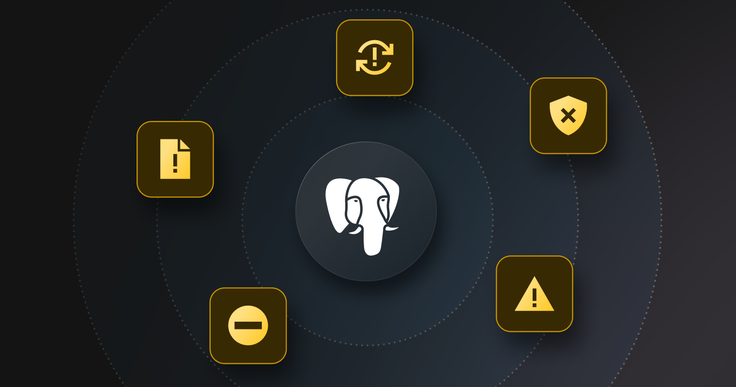PostgreSQL (Postgres) has earned a reputation as one of the most powerful and reliable open-source relational database systems. It's trusted by organizations of all sizes, from startups to enterprises, for everything from transactional systems to data warehouses. However, as applications scale and workloads become more demanding, even Postgres can show signs of strain. Users often try Postgres features or extensions (like partitioning, indexing strategies or connection pooling) to mitigate these performance issues before considering alternatives.

Here are five common signs your Postgres database is struggling to keep up, and how SingleStore helps you break through those bottlenecks.
1. Slow query performance, especially on complex joins
Problem
Queries that once returned results in milliseconds now take seconds or even minutes. This is particularly common when dealing with multiple joins, large tables or complex aggregations.
Why it happens
PostgreSQL is row-based and not optimized for high-speed analytical queries. As data grows, the cost of scanning and joining increases.
How SingleStore helps
SingleStore uses a distributed architecture with vectorized execution and columnar storage, making it ideal for real-time analytics at scale. Complex queries that drag in Postgres fly in SingleStore — especially when joins span large tables or involve filters on high-cardinality columns.
2. Frequent lock contention and deadlocks
Problem
You start noticing frequent lock wait events — or worse, deadlocks that require manual intervention.
Why does it happens
PostgreSQL uses Multi-Version Concurrency Control (MVCC), allowing concurrent reads and writes without locking. However under heavy transactional workloads — especially on hot rows or tables — Postgres can experience lock contention and performance degradation, often due to limitations in vacuuming, index maintenance or its single-node architecture.
How SingleStore helps
SingleStore also uses MVCC but is optimized for high-concurrency, distributed workloads. It reduces contention through lock-optimized data structures and a memory-first design, allowing more efficient handling of simultaneous transactions. The separation of compute and storage in the cloud version further reduces resource contention, enabling smoother scaling under load.
3. Data ingest can't keep up with real-time requirements
Problem
Your streaming data pipelines or IoT feeds overwhelm your ingestion rate. Batch loads are delayed, or stream inserts begin to pile up.
Why it happens
Postgres's write-ahead logging and single-node write architecture create natural limits to ingestion throughput, especially when writing tens or hundreds of thousands of records per second.
How SingleStore helps
SingleStore supports high-throughput ingestion from Kafka, Spark and custom pipelines with minimal latency. Its distributed ingest engine enables horizontally scalable writes so you can easily handle millions of rows per second.
Launch AI-driven features. Without hitting limits.
- Free to start.
- Start building in minutes.
- Run transactions, analytics & AI.
4. You're constantly archiving or pruning data
ProblemTo maintain performance, you resort to archiving old data or limiting the retention window, even though your business would benefit from analyzing historical trends.
Why it happensPostgress performance degrades as table sizes grow. Index bloat, vacuuming requirements and long query times often force teams to compromise on data retention.
How SingleStore helpsWith compressed columnar storage and distributed partitions, SingleStore handles massive volumes of historical data without the performance penalty. You can keep more data online, enabling deeper analytics and long-term trend analysis without tuning nightmares.
5. Scaling up hardware offers diminishing returns
ProblemYou've tried to fix performance by upgrading to more powerful (and expensive) hardware, but performance gains are marginal — and costs keep rising.
Why it happensPostgres wasn’t initially built for distributed scale. While extensions like Citus add distributed capabilities, they often introduce complexity and limitations that fall short of native scalability. Also, setting up, managing and optimizing a distributed Postgrescluster with Citus can be more involved than using a natively distributed database system like SingleStore.
How SingleStore helpsSingleStore runs on-prem or in the cloud, scales horizontally with minimal effort and supports both transactional (OLTP) and analytical (OLAP) workloads from a single engine. You get better performance and cost efficiency without rewriting your applications.
Summary
Postgres remains an excellent choice for many workloads and is supported by a strong community and ecosystem. But if you see signs of stress, consider a modern, distributed alternative in SingleStore to address performance and scalability issues.
SingleStore offers the performance of an in-memory database, the scalability of a cloud-native platform and the power of SQL, all in one package. Whether you're facing slow queries, data ingestion problems or infrastructure scaling issues, SingleStore is designed to help you go further, faster.
Start your free trial today and see the difference firsthand.
Frequently Asked Questions

-for-Real-World-Machine-Learning_feature.png?height=187&disable=upscale&auto=webp)

.png?height=187&disable=upscale&auto=webp)











